
Lyme Park is a large estate south of Disley, Cheshire, England, managed by the National Trust and consisting of a mansion house surrounded by formal gardens and a deer park in the Peak District National Park. The house is the largest in Cheshire, and is recorded in the National Heritage List for England as a designated Grade I listed building.

Tabley House is an English country house in Tabley Inferior, some 3 kilometres (1.9 mi) to the west of the town of Knutsford, Cheshire. The house is recorded in the National Heritage List for England as a designated Grade I listed building. It was built between 1761 and 1769 for Sir Peter Byrne Leicester, to replace the nearby Tabley Old Hall, and was designed by John Carr. The Tabley House Collection exists as an exhibition showcased by the University of Manchester.
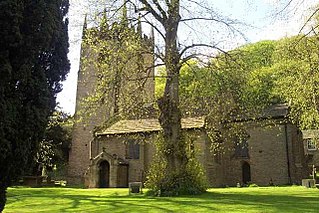
Pott Shrigley is a small village and civil parish in the unitary authority of Cheshire East and the ceremonial county of Cheshire, England. According to the 2001 census, the civil parish and village has a population of 289. The nearest town is Bollington to the southwest.
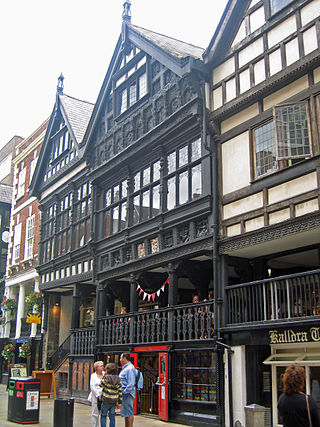
Bishop Lloyd's House is at 41 Watergate Street, and 51/53 Watergate Row, Chester, Cheshire, England. It is recorded in the National Heritage List for England as a designated Grade I listed building. The architectural historian Nikolaus Pevsner considered it to be "perhaps the best" house in Chester.
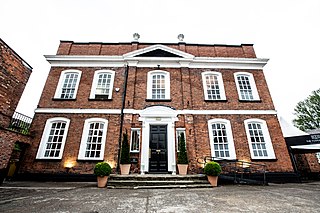
9 Mill Street is a Georgian house in Nantwich, Cheshire, England. The present building dates from around 1736 and is a grade II* listed building. Nikolaus Pevsner calls it a "fine, spacious" house, and the English Heritage listing describes it as a "substantial and well-detailed early, C18 Town House, which ... retains much original interior fabric." Formerly a town house, bank and political club, it is currently a restaurant and bar.
Butley Hall is a former large house, now converted into flats, in the village of Prestbury, Cheshire. It was rebuilt in 1777 for Peter Downes. The house was extended by an addition to the north in the 19th century, and converted into flats during the 20th century. It is constructed in sandstone rubble with ashlar dressings, it has Kerridge stone-slate roofs, and five brick chimneys. The main front of the house is in two storeys and seven bays. The central three bays protrude forwards and are surmounted by a triangular pediment. On each side of the front are wings with Venetian windows. To the rear of the house is the front of an earlier three-storeyed house dating from the 17th century. The house is recorded in the National Heritage List for England as a designated Grade II listed building.

Davenham Hall is a former country house to the southeast of the village of Davenham, Cheshire, England. It was built for Thomas Ravenscroft to replace a timber-framed house called Davenham Lodge. It dates from the middle or the later part of the 18th century, possibly from shortly before 1795, when Ravenscroft died. Substantial additions were made in the early 19th century. It is constructed in stuccoed brick, and has a slate roof. The house is in two storeys with a symmetrical entrance front of six bays. Occupying the middle two bays is a porch with four Tuscan columns and an entablature containing a triglyph. Above this, the central bays protrude slightly forwards and contain two windows, with a pediment above them and a parapet on each side. Figueirdo and Treuherz describe the interior as being "especially fine". The entrance hall contains Grecian plasterwork and a black marble chimneypiece. The drawing room has more delicate plasterwork, and a marble chimneypiece decorated with dancing figures. The central staircase hall is lit by a central dome, and has fan-shaped plasterwork. The staircase has a wrought iron baluster, and the first floor landing has a screen of four Doric columns. The house was converted into a nursing home in 1980. It is recorded in the National Heritage List for England as a designated Grade II* listed building.
Endon Hall is a country house to the south of Bollington and to the west of Kerridge Hill in Cheshire, England. It was built for William Clayton who developed a quarry nearby. Building of the house started in the 1830s, and it was enlarged in the 1850s. Associated with the house are two structures recorded in the National Heritage List for England as designated Grade II listed buildings. In the farm to the east of the house are stables, built at the same time as the house. They are constructed in coursed buff sandstone rubble with ashlar dressings, and have Kerridge stone-slate roofs. The stables are in two storeys, with a courtyard plan. They have a symmetrical front of five bays, with the central and end bays stepped slightly forward. In the centre bay is a coach entrance. The parapet is castellated. On the roof is a two-tier dovecote with a clock in the upper tier. Also on the roof is a hexagonal wooden open bellcote with a copper-domed roof and a weathervane. In the garden to the south of the house is a sandstone icehouse, built in about 1840.
Ingersley Hall, later Savio House, stands to the east of the town of Bollington, Cheshire, England. The house was built in about 1775 for John Gaskell. Extensions were added to it in 1833 for John Upton Gaskell. The house was sold by the Gaskell family in 1933. In the 1950s it was taken over by a religious order, the Salesians of Don Bosco, and renamed Savio House. As of 2011 the house is used as a retreat and activities centre for young people. The front of the house is constructed in ashlar, with the remainder in coursed sandstone rubble. The house is roofed in Welsh slate and has stone chimneys. It has a rectangular plan and is in two storeys. The architectural style is Greek Revival. The north front is symmetrical with five bays divided by pilasters. The porch is in Doric style. The west front has eight bays, the central three of which were in the original house. All the windows in the north and west fronts are sashes with 12 panes. The south door is in Tuscan style, and was probably moved from the west front. The house is recorded in the National Heritage List for England as a designated Grade II listed building. Also listed at Grade II is a former coach house to the south of the hall, built in about 1850, and converted into a conference hall in about 1950.
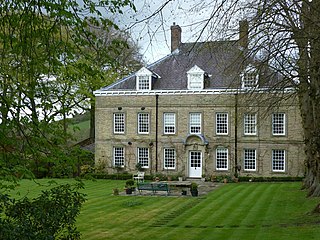
Langley Hall is a country house in the village of Langley, Cheshire, England. It was built in about 1650, and is described by the authors of the Buildings of England series as "a distinguished house". The house is constructed in coursed rubble with ashlar dressings and is roofed in stone slate. It has two-storeys and an attic. The entrance front is symmetrical with seven bays and a central doorway. Above the doorway is a cartouche containing a carved face. It is inscribed MAC 1696. The house is recorded in the National Heritage List for England as a designated Grade II* listed building. It has been converted into three flats.

Lawton Hall is a former country house to the east of the village of Church Lawton, Cheshire, England. The building has since been used as a hotel, then a school, and has since been converted into separate residential units. It is recorded in the National Heritage List for England as a designated Grade II listed building.

Lea Hall is a former country house standing to the northwest of the village of Wimboldsley, Cheshire, England. It dates from the early part of the 18th century, and was built for the Lowndes family. During the 19th century the house was owned by Joseph Verdin. Additions, including dormer windows, were made in the 19th century. During the 20th century the house was divided into three flats. The house is constructed in red brick with ashlar dressings and a tiled roof. It is in two storeys, with an attic and a basement. The roof is large and hipped, with a viewing platform. The entrance front is symmetrical, in five bays, the central bay protruding slightly forward. This bay contains a doorway with a swan's nest pediment decorated with scrolls, and containing a crest with the initials J V. The authors of the Buildings of England series describe the house as a "perfect brick box, delightful if just a little funny to look at". It is recorded in the National Heritage List for England as a designated Grade II* listed building.

Lower Huxley Hall is a moated manor house in Cheshire, England, located about 6.5 miles (10 km) southeast of Chester. It lies roughly halfway between the villages of Huxley and Hargrave, It dates from the late 15th century, with major additions and alterations in the 17th century. A small addition was made to the rear in the 19th century. It was originally a courtyard house, but only two wings remain. The house is designated by English Heritage as a Grade II* listed building.
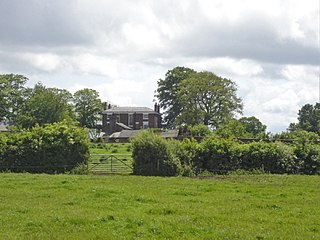
Stanthorne Hall is a country house standing to the west of the village of Stanthorne, Cheshire, England. It was built between 1804 and 1807 for Richard Dutton, who had purchased the estate from the Leicesters of Tabley. The house is constructed of brick with painted stone dressings and a slate roof. It is in three storeys with a symmetrical entrance front of three bays. The doorway is surrounded by Tuscan columns and an open pediment with a fanlight. The windows are sash windows. To the rear is a long wing. Inside the house, the entrance hall contains an open well staircase of three flights, and has a cornice with a frieze containing triglyphs. Two of the ground floor rooms have black marble fireplaces. The house is recorded in the National Heritage List for England as a designated Grade II listed building.

Stretton Hall is a country house in the parish of Stretton in Cheshire, England. It was built in about 1763 for John Leche. The house is constructed in brick on a sandstone basement, with painted stone dressings, and a slate roof. It has three symmetrical elevations. The entrance front is in three two-storey bays with a single-storey wing on each side. The central bay is canted, with five steps leading up to a doorway with a pediment. The windows are sashes. The garden front has similar windows, other than the wings, each of which contains a Venetian window. To the right of the house is attached a further wing, converted from the 17th-century stable of an earlier house. The house and former stable area is recorded in the National Heritage List for England as a designated Grade II* listed building. The sandstone garden walls are listed at Grade II.
Willaston Hall is a country house in the village of Willaston, near Nantwich, in the unitary authority of Cheshire East, England.
Willot Hall is a country house in the parish of Prestbury, some 4.5 km to the east of Wilmslow, Cheshire, England. It originated as a medieval hall house in the later part of the 15th century. This was encased in stone in the 17th century. Later in the century, a service wing was added. The house was restored and extended between 1933 and 1939, moving the entrance and reopening the great hall to the roof. It is constructed partly in buff sandstone rubble and partly in brick, with Kerridge stone slate roofs. It is in 2½ storeys, with a four-bay entrance front, the left bay being larger than the others. The left bay contains mullioned windows and is gabled. The other bays contain a doorway, smaller mullioned windows, and gabled dormers. The house is recorded in the National Heritage List for England as a designated Grade II* listed building.
Pott Shrigley is a civil parish in Cheshire East, England. It contains 19 buildings that are recorded in the National Heritage List for England as designated listed buildings. Of these, one is listed at Grade I, the highest grade, one is listed at Grade II*, the middle grade, and the others are at Grade II. Apart from the village of Pott Shrigley, the parish is almost entirely rural. Most of the listed buildings are farmhouses and farm buildings, houses and cottages. Parts of the Macclesfield Canal run through the parish, and the listed buildings associated with this are a bridge, an aqueduct, and fence posts. The other listed structures are a church and churchyard cross, a school, a hotel and leisure centre, a telephone kiosk, and a parish boundary stone.

Ince Blundell Hall is a former country house near the village of Ince Blundell, in the Metropolitan Borough of Sefton, Merseyside, England. It was built between 1720 and 1750 for Robert Blundell, the lord of the manor, and was designed by Henry Sephton, a local mason-architect. Robert's son, Henry, was a collector of paintings and antiquities, and he built impressive structures in the grounds of the hall in which to house them. In the 19th century the estate passed to the Weld family. Thomas Weld Blundell modernised and expanded the house, and built an adjoining chapel. In the 1960s the house and estate were sold again, and have since been run as a nursing home by the Canonesses of St. Augustine of the Mercy of Jesus.

Brough Hall is a historic country house in Brough with St Giles, a village in North Yorkshire, in England.















